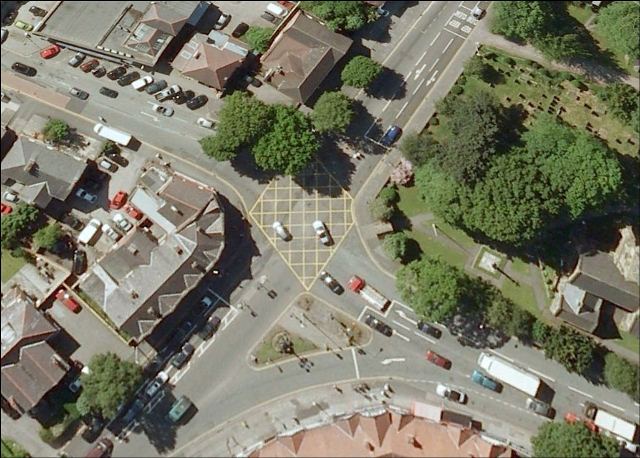From Better! Cities & Towns:
It’s been nearly a year since a major traffic light was removed at an intersection with 26,000 vehicles per day, heavily used by truck traffic in Poynton, Cheshire, England. (Map here.) A section of the town’s High Street was also renovated so that pedestrians, bicyclists, and vehicles all mix. The volume of vehicles is nearly double the upper limit for “shared space” intersections according to industry standards.
Before:

,
“This was the most ambitious shared space project — certainly in the UK — any anywhere else that I am aware of,” says Ben Hamilton-Baillie, a British urban designer who led the project.
Accidents have gone down so far, although Hamilton-Baillie cautions that it is too early to draw conclusions on safety. Traffic queues have been drastically reduced, despite an increase in pedestrian space of more than 100 percent.
After:

.













Put the Poynton and Burrard intersection stories together. What would shared space at Burrard and Cornwall look like?
Shared space has proven to be problematic for young and old cyclists and walkers as well as the visually impaired http://www.walk21.com/papers/503A%202%20Havik%20Shared%20Space.pdf
Shared spaces are fine on local streets with little traffic where speeds will be really low. On high volume streets like Burrard and Cornwall, it would be horrible for cyclists and peds.
Now it could be fine with automated vehicles that would always yield to peds and cyclists and always following the rules. Can’t wait!
Richard, the link you provide deal only with visually impaired people. and we know how to address their concerns. I could be interested to know where you get the idea that “Shared space has proven to be problematic for young and old cyclists”.
If it is the same problem that car are facing (can’t go fast): that is per design 😉
At the end, overwhelmingly shared space can claim that “Accidents have gone down so far, despite an increase in pedestrian” and that is what matter, and the Poynton experiment brings it to a new level in term of sustained level of traffic (thought it is not a real shared space) and I am pretty sure naysayer was saying that “it would be horrible for cyclists and peds”.
I also think that the recently built scramble intersection in Richmond was an expensive step in the wrong direction, the right one being a “shared space”
The great thing about separated bike lanes and sidewalks is that they are much more relaxing to use. The whole premise of shared space is to make walking, driving and cycling more stressful by always having to look out for stuff. I really don’t want to be human traffic calming. Let cement to that. Both the young and the old have perception challenges that make shared space a poor solution.
Life is stressful enough without urban theorists purposely more stressful.
The VPD refuses to enforce 30kph on bikeways. Try and get them to enforce 15kph.
http://velobuc.free.fr/download/SharedSpace-Walk21.pdf
All showcases relate to situations where the road has both a sojourn and a traffic function and where it proved to be impossible to limit the quantity of car traffic. Here Shared Space offers a compromise, but the toll is paid by pedestrians and bicyclists.
There appears to be a large discrepancy between the theoretical philosophy of Shared space and its actual practise. Due to participation of the population and commercial interests in practise the principle of sharing space is – fortunately – not implemented so rigorously as the concept name suggests. Thus compensation is offered for the weak points in the vision, caused by flaws in the assumptions made.
In general one can conclude that in all show cases objective traffic safety indeed has improved. With regard to road safety Shared Space is favourable compared to the old situation, but probably a Sustainable Safety principles based design, also taking into account spatial quality, can produce even better results.
There are a number of questions that need to be dealt with, namely:
• Improvement by creating danger?
• Can the approach be implemented successfully on traffic arteries? What about the
barrier effects?
• Can the approach be implemented in metropoles, where traffic is more hectic and
social relations more anonymous?
I think that could take the form of a roundabout – but those can be difficult for pedestrians.
The ghost of Hans Monderman lives on!
Actually, seems like it is often used as an easy way out when the is not the political will to ban motor vehicle traffic.